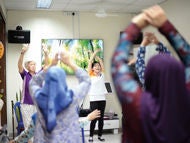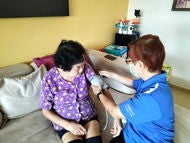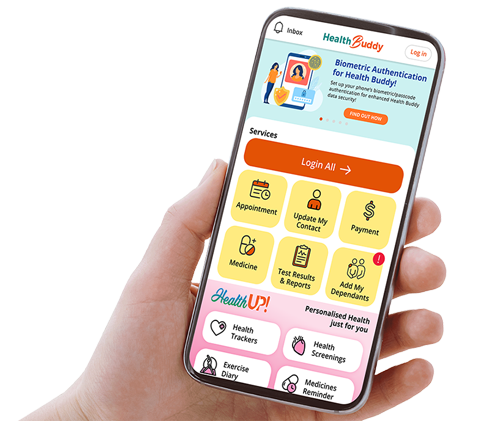
We humans are not perfect, and that's probably why we occasionally fumble doing the simplest things. However, there are moments when we are actually set up to fail. Here are eight errors you might have encountered at work or at home which you shouldn't bash yourself too hard about.
By Yin Shanqing, Senior Principal Human Factors Specialist, KKH
1. Pushing a door that's meant to be pulled (or vice versa)

GIF via GIPHY
Named after Professor Don Norman, a Norman door is a poorly designed door that confuses or fails to give you an idea whether to push or pull.
2. Flicking the wrong switch

GIF via Domics.me
Without any labels or geographical association, a group of switches seldom gives any clue as to what it controls.
Then comes the game of trial and error we play trying to find the right switch for the right light. At times, this may also mean annoying the other people in the room trying to get some work done.
3. Misinterpreting an abbreviation 
GIF via GIPHY
For the longest time, medical residents would come to me with questions about ACP. In my mind, I thought it was wonderful that they were already learning about Advance Care Planning. (They weren't. They were referring to their Academic Clinical Programmes).
Singapore can be quite obsessed with abbreviations. While the Joint Commissions International recommends the use of standardised abbreviations or to use none at all, different organisations may abbreviate different terms differently.
An abbreviation can also have different meanings. In the hospital, PT means physiotherapist, while pt means patient. Confusion comes easily when we find a variety of shorthand writings along with medical abbreviations.
The science of human factors Human Factors is the study of all the factors that make it easier to do the work in the right way. The science of human factors uses various disciplines such as anatomy, physiology, physics and biomechanics to understand how people perform under different circumstances. In its broadest sense it incorporates the human–machine interactions (including equipment design) and human–human interactions such as communication, teamwork and organisational culture. One can apply human factors knowledge to wherever humans work. In healthcare, human factors knowledge can help design processes that make it easier for doctors and nurses to do the job right. Human factors can show us how to make sure we use safe prescribing practices, communicate well in teams and hand over information to other health-care professionals. (Source: WHO Patient Safety Curriculum Guide) |
4. Selecting the wrong item in a drop-down menu

Many of today's Computerised Physician Order Entry (CPOE) systems as well as health IT interfaces incorporate drop-down menus for easy selection. Unfortunately, many of these menus often feature a long list of options with similar-looking names (e.g. drugs).
And due to limited screen space, these options tend to appear in small fonts and displayed closely together. This makes it easy for users to accidentally select the wrong option, only to discover the mistake much later on when someone checks or notices.
5. Forgetting verbal instructions
GIF via GIPHY
The truth is, our memory is not that reliable, and that's not entirely our fault! When listening to a verbal instruction, our brains typically take a few seconds to process and keep it active in our mind, or store it in our long-term memory in hopes that we will recall it correctly at the right time.
This is highly susceptible to errors, especially if you work in a highly-interruptive, multi-tasking environment such as health care. Make sure you take notes!
6. Hearing the wrong lyrics
GIF via GIPHY
As if forgetting instructions isn't bad enough, we at times may also hear them wrongly too. This can be down to many factors: accent, articulation, presence of noise, and context of the situation!
Our expectations or preconceived ideas can also affect what we see or hear, simply because we think it is what we are looking for. A few people once thought I'd be attending an event (I didn't) because they heard a name that sounded like mine, and it was the kind of event at which I'd likely be present.
We may also turn to a more familiar explanation or interpretation just to make it easier for us to make sense of what we perceive. Our brains are just not as perfect as we think they are, and the occasional "mondegreens" of life are inevitable.
7. Grabbing the wrong salt or pepper shaker
GIF via GIPHY
This problem isn't just limited to the dining table. We are all too familiar with drugs and medical devices that look similar, and the disaster they can cause when placed next to one another. While we have begun talking about "lookalikes" and "soundalikes" (affectionately abbreviated as LASA – see, another abbreviation!), we generally have little say over the confusing designs produced by pharmaceuticals and device companies.
8. Mistaking human factors as the means to manage human behavior

GIF via Tumblr
Whenever a human error occurs, human factors specialists would come in and explain the science behind why it occurred. As a result, people tend to think that human factors specialists can also influence and change bad behavior. This perspective is only partially true.
As individuals, humans are highly varied and unpredictable in their behaviours. So human factors specialists generally do not manipulate an individual's behaviour directly, but instead address systemic issues – typically through design changes in products, procedures and systems. The result? Improving human performance and reduce future errors, so that we don't set ourselves up to fail.
Dr Yin Shanqing is Senior Principal Human Factors Specialist at KK Women's and Children Hospital. His work focuses on the application of human factors principles and methodologies in healthcare research and patient safety. Dr Yin is particularly interested in cognitive ergonomics; looking into topics such as attention management, memory, situation awareness and prediction.
He has a Ph.D in Human Factors Engineering and a B.Sc. in Psychology, and is also a certified private pilot.
Contributed by




















